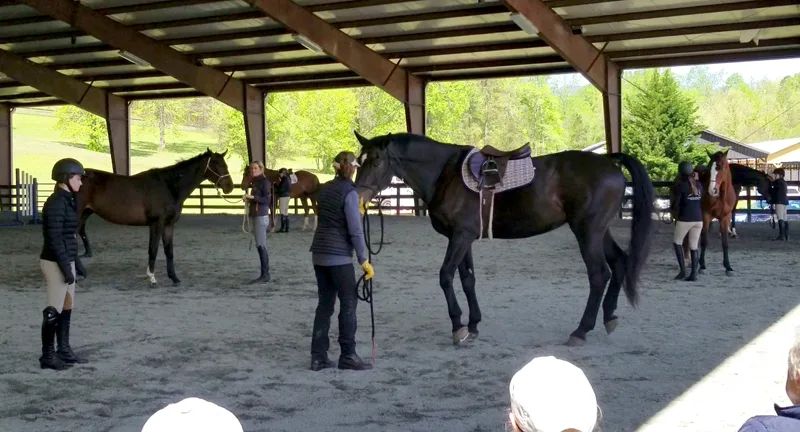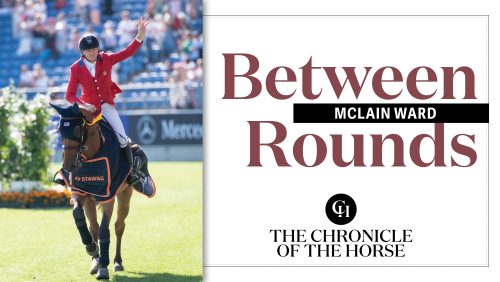In her latest clinic held at the Tryon Riding and Hunt Club in Columbus, North Carolina, Melanie Smith-Taylor paired up with Robyn Miller to create an experience that focused on the importance of creating a partnership of mutual trust and respect between each horse and rider. Good groundwork, Smith-Taylor explained, was a crucial practice and a way to work through problems before putting a foot in the stirrup.
“I feel we owe it to the horse to give him a basic understanding of the meaning of the aids, which is the basis of communication for all mounted work,” said Smith-Taylor. “In order to influence his body, we must have the horse’s mind with us. Groundwork helps us work on the outside of the horse to get to the inside and become their place of peace.”
Miller, who led the groundwork portion of the clinic, reiterated Smith-Taylor’s point, saying that “groundwork is a checklist for how your horse responds to pressure and whether or not he is light or braced to the aids to go forward, backward, move left and right. Groundwork also allows you a safer vantage point to warm up your horse as you check for soundness and readiness to ride.”

Each session began with groundwork to help riders’ communication with their horses. Arden Cone Photos
For each session participants brought their saddled horses to the ring in rope halters with 12-foot lead ropes attached by knots. The clinicians wanted a thinner rope halter because gives a clearer communication than flat nylon or leather halters.
Each groundwork session began with a series of exercises designed to develop the horse’s balance, encourage self-carriage, build a strong core and topline and soften any braces the horse may have.
Miller wanted participants to communicate through the pressure they asserted with their body language—referred to as “presence” throughout the clinic—and used the release of pressure as the horse’s reward. Smith-Taylor added that horses will feel the same on the lead rope as they do on the rein and asked participants, “Do you prefer your horse to be heavy or light?”
Miller borrowed a participant’s horse to demonstrate and explain each exercise. First, she asked the horse to bend his neck laterally in each direction. She emphasized that participants should not pull the horse’s head into the bent position. “We teach horses what we want them to do with the ask of an aid. They learn from the release of that aid at the moment of the desired response,” she said. “If you consistently release for each try with timing, when you reach for them, they will begin to reach for you,” Smith-Taylor added.
ADVERTISEMENT
Miller’s second exercise was untracking the hind end, which engages the horse’s core. The goal is to encourage the horse to step the inside hind leg forward on a diagonal in front of the outside hind leg. Miller demonstrated the movement by asking the horse to bend his head toward her as she brought up the presence in her body, directing her energy and focus to move the horse’s hindquarter.
“If the pressure from your presence isn’t enough to move the horse, firm up by increasing pressure on the hindquarter through the use of the lead rope’s free end and tapping the horse if necessary, until the horse makes an attempt to step over,” said Smith-Taylor. “All pressure should be released when the horse attempts the movement. Do as little as it takes, but as much as you need so the horse begins to respond to the lightest ask—just as you would with your leg on their back.”

Participants took the same exercises they used on the ground and applied them once they were in the tack.
Next, Miller showed the group how to send a horse in a “united circle,” with all four quarters moving equally. The horse’s hoof pattern should create two side-by-side tracks as he shapes his body to the size of the circle. Smith-Taylor added, “Straightness is the same on a circle as on a straight line; it occurs when the horse’s spinal column overlaps the track he is on.”
From the united circle, Miller illustrated how to gain control of an overly-impulsive horse by untracking the hind end to a stop. Untracking the hindquarters diminishes the horse’s ability to power forward, whether on the ground or under saddle. A soft bend into a one-rein stop is always preferable in these cases because, with two reins, he can brace against you and run off.
Next, Miller showed riders the drift, comparable to a leg yield on a circle. She instructed participants to ask the horse to continue to untrack, with his hindquarters making a larger circle than the front end. This exercise is beneficial in that the horse finds his balance laterally as he engages one hind leg at a time before trying longitudinal engagement with both hind legs. Getting the horse soft in the drift is the basis for a correct and successful one-rein stop.
After the day’s groundwork was finished, participants bridled and mounted their horses, and Miller walked the riders through the execution of each of the groundwork exercises under saddle, explaining how the rein and leg aids are applied with the same mindset as they are on the ground.
Smith-Taylor then took leadership of the session and guided the group through serpentines, circles and straight lines over poles on the ground, working on timing, transitions and adjustability. She had set up different gymnastic exercises around the ring and used each one individually before combining them as a course.
ADVERTISEMENT
She asked the riders to “punctuate” each exercise by stopping straight and shifting the horse’s weight back, resetting his balance without moving his feet. The exercises were challenging, but they were executed over ground poles or low simple jumps. “Make the easy tasks difficult, so the difficult tasks become easy when you get to the horse show,” Smith-Taylor said.
One of those exercises was three raised rails placed 45 feet apart, and riders were asked to vary the number of strides between the rails. For example, she asked one student to do five steady strides between the first two poles and circle after the second pole, to give the horse a release from pressure, before riding through the second and third poles in a quiet six strides.
Another was a short one-stride set up on a curve at the end of the ring, which could be jumped off either lead. Smith-Taylor asked riders to trot over cavaletti set up on the opposite side of the circle then transition to canter for the jumps. She told riders to think ahead of their horse and keep their eyes on the next obstacle. “Your eyes are the lightest turning aid,” she said. “Let your horse know your intention so he can prepare.”
A series of jumps set on a zigzag down the center of the arena provided a challenging layout for multiple exercises. Smith-Taylor wanted to encourage the horse to “think back to the rider” and wait to be directed on landing. Sometimes she had the riders do reverse turns after the fence—the opposite direction of where the horse would expect to turn. Another time riders jumped two fences on a blind curve where the horse thought he was going straight. A third option was to angle several fences together with only one or two strides in between. The variety of options meant riders and horses had to keep their focus and stay in the moment.
Smith-Taylor and Miller ended each session with questions. Smith-Taylor reminded participants that horses are wired with the same survival instincts whether they are born in the wild or in domestication, and Miller reiterated that building a bond and partnership through groundwork is an important part of helping the horse find you as his place of peace and security.
Smith-Taylor concluded the clinic by saying, “The world has plenty of riders but not nearly enough skilled horsemen. Embracing groundwork helps you truly connect with the horse and develop better awareness, feel, timing and accuracy. It takes a lifetime, but we can all learn so many lessons from the horse.”
















